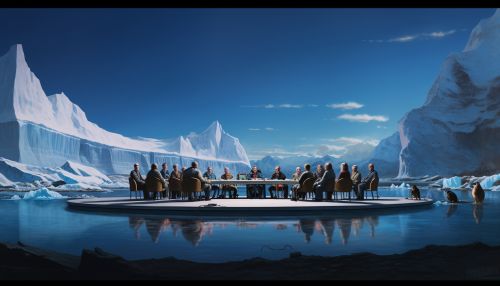Antarctic Treaty System
Introduction
The Antarctic Treaty System (ATS) is a complex of arrangements for the regulation of relations among states in the Antarctic. Established by the Antarctic Treaty of 1959, the system prohibits military activity, mineral mining, nuclear testing and nuclear waste disposal. It also supports scientific research and protects the continent's ecozone. Ongoing experiments are conducted by more than 4,000 scientists from many nations.


History
The Antarctic Treaty System was established to ensure in the interest of all mankind that Antarctica shall continue forever to be used exclusively for peaceful purposes and shall not become the scene or object of international discord. The Treaty was the first arms control agreement established during the Cold War period.
Treaty System
The Antarctic Treaty System is a global agreement that regulates international relations with respect to Antarctica. It is designed to ensure that Antarctica is used for peaceful purposes only, and that there is freedom of scientific investigation on the continent.
Antarctic Treaty
The Antarctic Treaty, the cornerstone of the system, was opened for signature on December 1, 1959, and officially entered into force on June 23, 1961. The main purpose of the Antarctic Treaty is to ensure that Antarctica is used for peaceful purposes only.
Other Components
The Antarctic Treaty System also includes the Protocol on Environmental Protection to the Antarctic Treaty, the Convention for the Conservation of Antarctic Seals, and the Convention for the Conservation of Antarctic Marine Living Resources.
Governance
The Antarctic Treaty System is governed by meetings of the consultative parties to the Antarctic Treaty, which includes all the parties that are entitled to participate in the decision-making process.
Consultative Meetings
The Antarctic Treaty Consultative Meetings (ATCM) are the primary decision-making body of the Antarctic Treaty System. These meetings are held annually and are attended by members of the Antarctic Treaty.
Secretariat
The Antarctic Treaty Secretariat, established in 2004, provides support for the administration of the Antarctic Treaty System.
Environmental Protection
One of the main objectives of the Antarctic Treaty System is the protection of the Antarctic environment. This is achieved through the Protocol on Environmental Protection to the Antarctic Treaty, which was adopted in 1991 and entered into force in 1998.
Protocol on Environmental Protection
The Protocol on Environmental Protection to the Antarctic Treaty provides for comprehensive protection of the Antarctic environment and dependent and associated ecosystems.
Conservation Measures
The Antarctic Treaty System also includes measures for the conservation of Antarctic fauna and flora, as well as measures for the conservation of Antarctic marine living resources.
Scientific Research
The Antarctic Treaty System promotes international cooperation in scientific research in Antarctica. This is facilitated by the freedom of scientific investigation in Antarctica and cooperation on the part of the Antarctic Treaty Parties.
Research Stations
There are numerous research stations in Antarctica, operated by various nations. These stations are used for a wide range of research activities, including biological, geological, atmospheric and oceanographic studies.
International Cooperation
International cooperation in scientific research in Antarctica is a key aspect of the Antarctic Treaty System. This is facilitated by the exchange of information and personnel among the Antarctic Treaty Parties.
